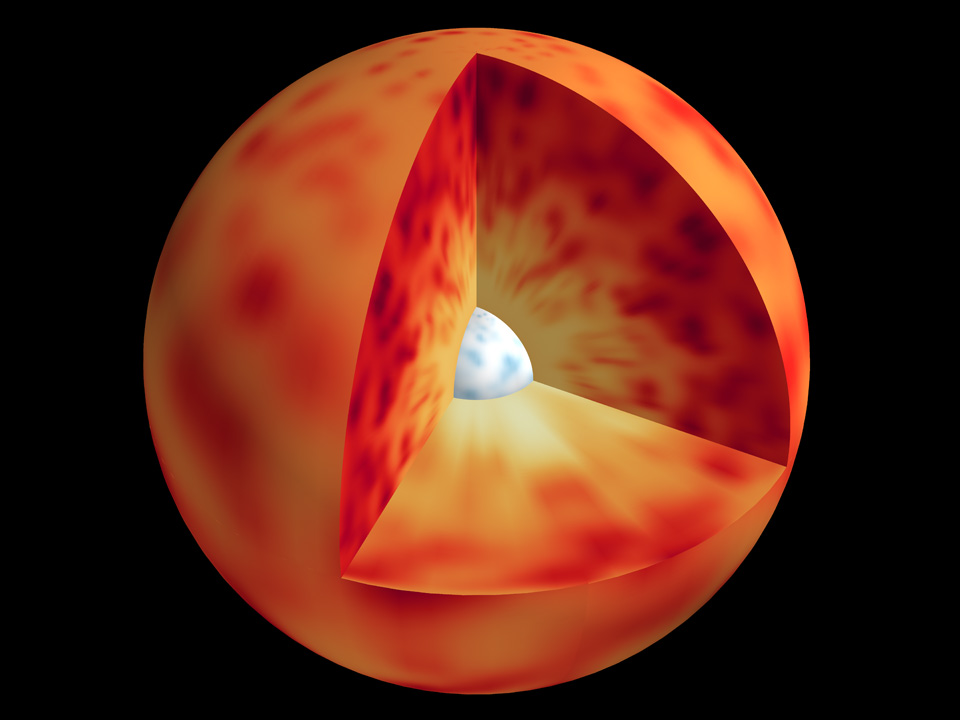







| BOOKS | F. A. Q. | ARTICLES | TALKS | ABOUT KEN | DONATE | BEYOND OUR KEN |
|---|
By Ken Croswell
Published on ScienceNOW (December 7, 2011)

A giant disguise: Although the surface of a cool giant star usually rotates slowly, its core--shown here as white and blue--spins fast. Credit: Paul Beck.
Beauty can be just skin-deep. So can stellar spin. Cool giant stars usually have surfaces that rotate slowly, but now NASA's Kepler spacecraft has revealed that their cores spin far faster. By stirring up a star's interior, rapid rotation can affect how a star lives and dies. Furthermore, because our Sun will one day become a giant, the discovery provides insight into its future.
Today our Sun is a main-sequence star, converting hydrogen into helium at its core. When the core runs out of hydrogen, 6.4 billion years from now, the element will begin burning in a layer around the core, making the Sun expand, brighten, and cool until it becomes a yellow giant, then an orange giant, and finally a red giant. Giants are rare, accounting for less than 1 percent of all stars, but because of their brilliance--they typically emit 100 times more light than our Sun--they make quite a splash in the night. The fourth brightest nighttime star, named Arcturus, is an orange giant, and the sixth brightest, Capella, consists of a pair of yellow giants.
Astronomers measure how fast a star's surface spins by exploiting the Doppler shift. One side of a star spins toward us, producing a blueshift, while the other side spins away, producing a redshift. That means every spectral line gets smeared out, and the broader the spectral lines, the faster the spin. Such observations show that the surfaces of most yellow, orange, and red giants rotate slowly--but the observations say nothing about what's happening beneath the surface.
Now Paul Beck of the Catholic University of Leuven in Belgium and his colleagues have used data from the Kepler space observatory to study the cores of three yellow giant stars named KIC 5356201, KIC 8366239, and KIC 12008916. The stars are only 20 to 50 percent more massive than the Sun, but they're about five times larger and 800 to 950 Kelvin cooler.
Kepler monitors tiny dips in starlight that occur when planets pass in front of their stars. But vibrations running through a star also cause starlight to vary. Just as seismologists employ earthquakes to probe our planet's mantle and core, so astronomers use these so-called asteroseismological vibrations to study stellar interiors. From more than a year's worth of Kepler data, Beck and his colleagues report online today in Nature that the cores of all three giant stars spin at least 10 times faster than their surfaces.
"This is really a beautiful result," says astronomer Marc Pinsonneault of Ohio State University in Columbus, noting the frustration astronomers face in being unable to observe something as crucial as a star's internal spin. "It's been a terrible problem: we know that rotation is important, we know that it can change the lives of stars quite a bit, but we've had surprisingly little data on what the insides of stars are actually doing." Pinsonneault says the discovery suggests that when the Sun becomes a giant, it will also have a fast-spinning core, which may affect how the Sun sheds its outer atmosphere and transitions from a red giant to a white dwarf.
Beck says that elementary physics can explain his finding. When a star's core runs out of hydrogen, it contracts. "Similar to an ice skater who's doing a pirouette, when you pull your arms toward you, you start to spin faster," Beck says, and so the star's core spins up. Just the opposite happens to the star's surface: it expands, so it spins more slowly.
Ken Croswell is an astronomer and the author of The Lives of Stars.
"A stellar picture of what we know or guess about those distant lights."--Kirkus. See all reviews of The Lives of Stars here.
| BOOKS | F. A. Q. | ARTICLES | TALKS | ABOUT KEN | DONATE | BEYOND OUR KEN |
|---|